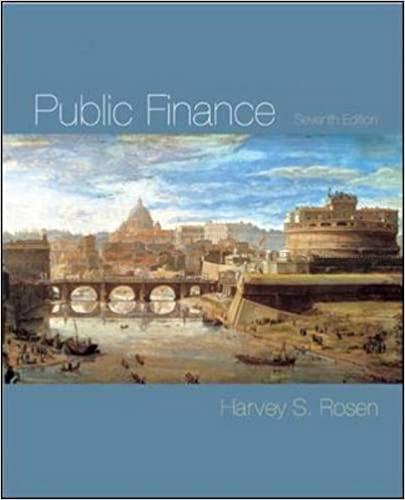Question
Case 5: Lachlan and Chloe Martin Lachlan Martin and his wife Chloe are both 50 years old, have three children, and live in Syracuse, New
Case 5: Lachlan and Chloe Martin
Lachlan Martin and his wife Chloe are both 50 years old, have three children, and live in Syracuse, New York. Lachlans father, Liam Martin, recently died and left his entire estate to Lachlan. Lachlan expects to receive his after-tax inheritance of $3.0 million in 1year. The Martins both plan to retire at that time and are meeting with Zoe White to help them establish an investment plan. Their children are ages 17, 16, and 14. All three earn scholastic honors and plan to go to college. Lachlan and Chloe have continuously promised to pay most if not all of their college expenses.
The Martins currently own a home valued at $600,000, do not have an investment portfolio, and do not consider their home as part of their investable assets. In one year, the Martins outstanding debt will be $450,000 (home mortgage) and $60,000 (other debts). The Martins will pay off all their debt when they receive the inheritance.
The Martins currently have a combined after-tax salary of $200,000, current-year living expenses of $150,000, and annual mortgage payments (principal + interest) of $37,000. Lachlans company will pay him an after-tax pension of $50,000 starting in one year when he retires, with the payments increasing by the rate of inflation, expected to be 3% annually. His employer will continue to pay Lachlan and Chloe's medical costs until death. The pension and health benefits will continue to Chloe, if Lachlan dies first. The Martins expect their living expenses will also continue to grow at the rate of inflation until one of them dies. At that time, they expect the survivors living expenses will decrease to 75% of their combined expenses, and then continue to grow at the rate of inflation.
The Martins intend to fund living expenses during retirement with Lachlans pension and the investment income generated from the portfolio of assets they constructfrom the inheritance. The Martins want their portfolio to be invested conservatively, and want to maintain the real value of their investable assets over time. They plan to leave 75% oftheir estate to their children with the remainder going to various charities. All income and realized capital gains are taxed at 25%. Their assumed annual effective tax rate is 20%.
When specifically asked, the Martins respond, We want to avoid overly-riskyindividual investments and would like our portfolio to be relatively stable and not experience any significant losses. We do not expect any unusual expenses in the short-run, but we want to maintain a comfortable cushion of emergency funds.
Instructions:
To properly assist clients, a financial advisor must know the clients current situation and plans for the future. To accomplish this, the advisor must meet with the client to develop an Investment Policy Statement, IPS. The Objectives and Constraints portion of the IPS (as defined by CFA Institute) is extremely important.On the following pages, you will see questions related to Investment Policy Statements in general as well as tables containing the objectives and constraints section of an IPS.
Part 1: Answer the following questions from the perspective of a financial advisor.
- What is an Investment Policy Statement, IPS, and what should it contain? Why is it important to develop an IPS before determining the appropriate asset mix for your client?
- How often should you meet with or contact your client to determine whether the clients situation has changed and whether the clients IPS should be updated? What sorts of things would require an update to a clients IPS?
- After reading an article, your client is very excited about a new stockand wants you to add it to her portfolio. Consideringyour clients objectives and constraints, what must you do before adding the stock toher portfolio?
Part 2: Objectives and Constraints
Table 1: Objectives and Constraints for the Typical Investor.
Define the components listed and explain what must be considered when determining each for the typical individual investor. (Be sure to consider the clients current situation and long-term plans.) You may use any website as resource, but be sure to include the site address in your reference list on the last page.
| Objectives and Constraints for the Typical Individual Investor | ||
| Objectives | Risk Tolerance |
|
| Return Objective |
| |
| Constraints | Time Horizon |
|
| Liquidity Needs |
| |
| Legal and/or Regulatory Considerations |
| |
| Tax Considerations |
| |
| Unique Concerns |
| |
Table 2: Objectives and Constraints for Lachlan and Chloe Martin.
Explain each component as it relates to the clients, Lachlan and Chloe Martin. Be very specific, using the numbers given in the case. (Be sure to consider the Martins current situation and their long-term plans, whether specifically stated or implied.)
| Investment Policy Statement for Lachlan and Chloe Martin: Objectives and Constraints | ||
| Objectives | Risk Tolerance |
|
| Return Objective |
| |
| Constraints | Time Horizon |
|
| Liquidity Needs |
| |
| Legal and/or Regulatory Considerations |
| |
| Tax Considerations |
| |
| Unique Concerns |
| |
Step by Step Solution
There are 3 Steps involved in it
Step: 1

Get Instant Access to Expert-Tailored Solutions
See step-by-step solutions with expert insights and AI powered tools for academic success
Step: 2

Step: 3

Ace Your Homework with AI
Get the answers you need in no time with our AI-driven, step-by-step assistance
Get Started


